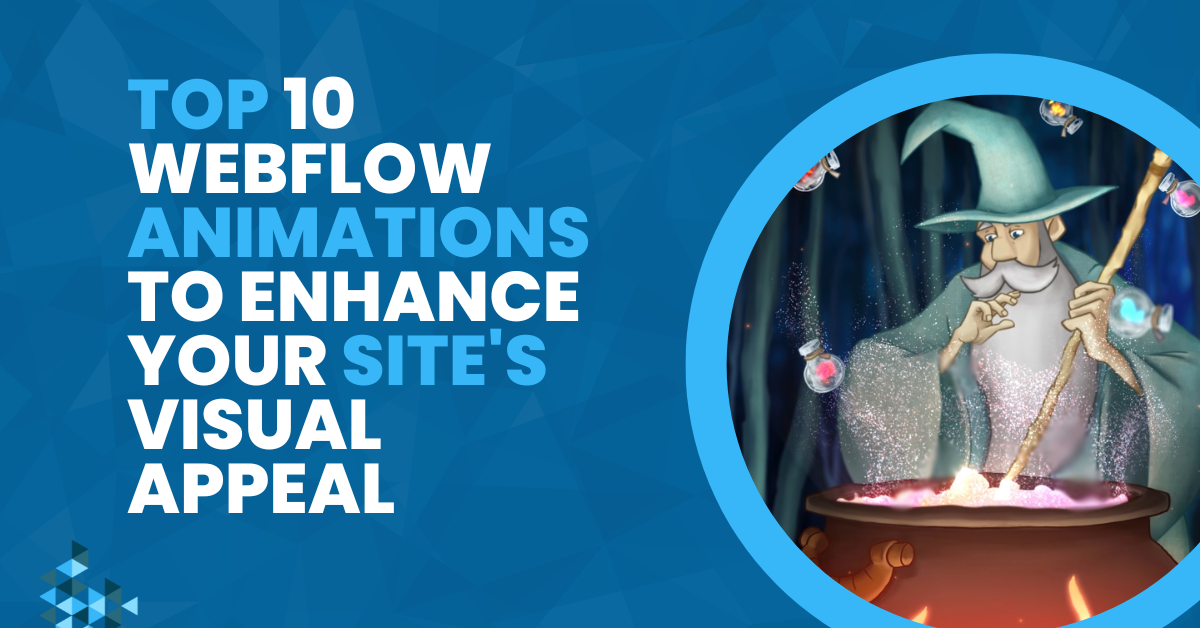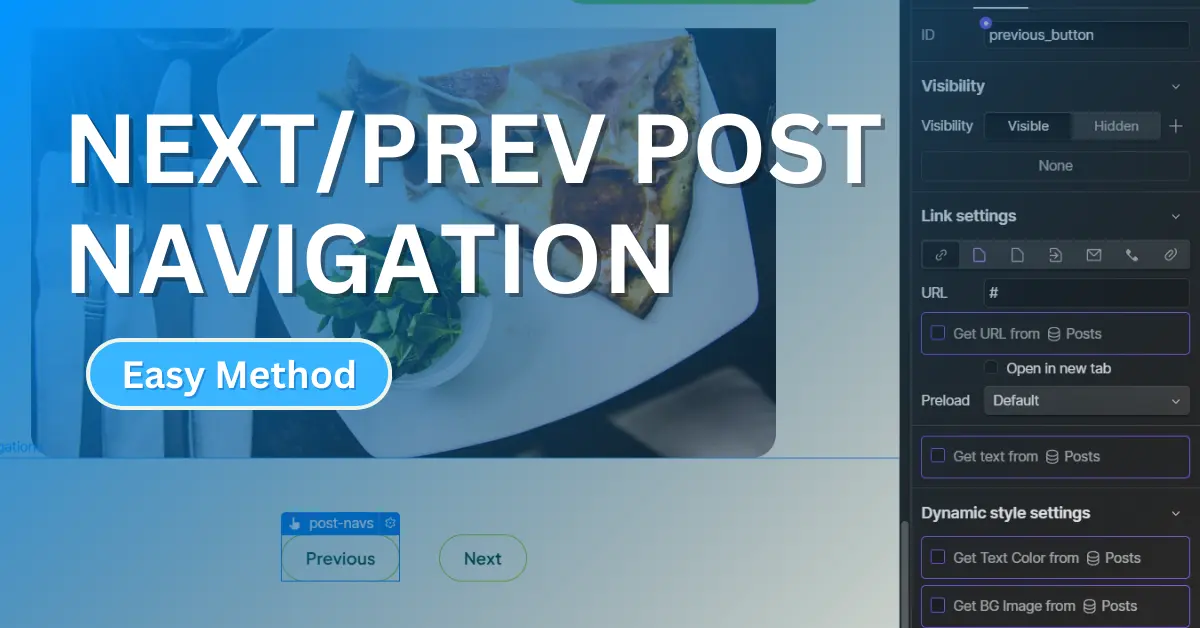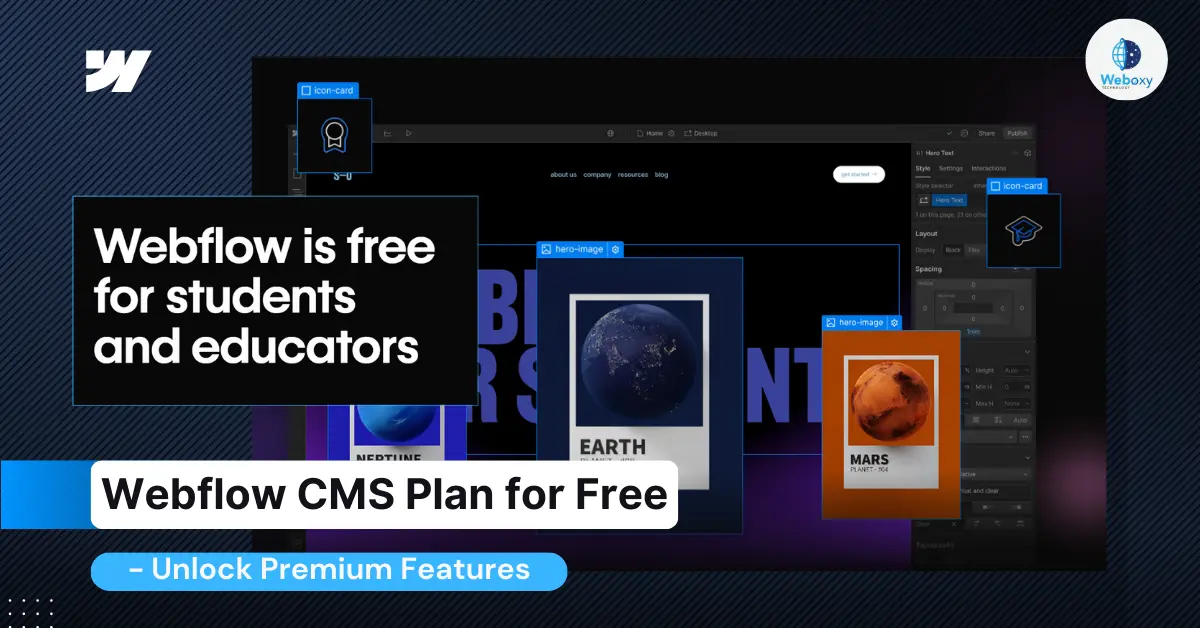Importance of Animations in Web Design
Nowadays, web design is experiencing significant growth and reaching new heights of professionalism. Animation in Webflow web design is essential for developing a strong visual identity, enhancing branding, and improving user experience. It provides seamless interactions, aids in storytelling, and encourages user engagement, making websites more dynamic and appealing.
Most visitors who land on a website and experience engaging animations tend to stay longer, as these animations enhance their overall experience and keep them interested.
Webflow and Its Animation Capabilities
Webflow is setting a new trend in website development with its highly creative capabilities for adding animations. It eliminates the hard work traditionally required by developers by enabling drag-and-drop animations through simple, intuitive methods. Webflow promotes various techniques for incorporating creative animations into websites, making the process accessible and efficient.
Methods for making animations
- Element-based Animations – Applied to specific elements (e.g., fade in, move, scale).
- Page Load Animations: Triggered when a page loads.
- Scroll-based Animations: Triggered by scrolling actions.
- Mouse-based Animations: Triggered by mouse movements or clicks.
Top 10 Webflow Animations to Enhance Your Site’s Visual Appeal
1. Smooth Scroll Animations

Smooth scroll animations generate a fluid, uninterrupted motion as users scroll through webpages, improving user experience by seamlessly transitioning between page sections. These animations effortlessly guide users through portfolios, landing pages, and narratives, spotlighting content effectively. They offer a no-code approach with built-in tools, simplifying the creation of smooth scroll effects.
Utilize Locomotive Scroll in Webflow for advanced and smooth web scrolling effects, adding a sophisticated layer of interaction and engagement to your website.
Tips for Effective Smooth Scroll Animations
- Keep It Smooth: Avoid abrupt or jarring motions.
- Use Sparingly: Enhance key elements without overwhelming the user.
- Test Performance: Ensure animations do not negatively impact page load times or performance.
- Custom Integration: Locomotive Scroll in Webflow for advanced and smooth web scrolling effects
2. Hover Effects

One of the most crucial effects on websites is the hover effect. These effects are commonly used for navigation links as well. Most websites incorporate hover effects that dynamically change colors and background colors, adding interactivity and visual appeal.
With Webflow’s intuitive interface, designers can easily implement various hover effects, including image transformations, color changes, and animations, to create dynamic and immersive web experiences without the need for coding. These effects can be applied to buttons, links, images, and other elements, allowing designers to customize user interactions and effectively communicate information or calls to action.
Tips for Effective Hover Effects
- Keep it subtle and Smooth
- Use hover effects purposefully
- Test across devices
- Optimize performance
- Experiment and iterate
- Stay updated
3. Loading Animations

Loading animations are popular nowadays. These animations are displayed while a page and its content are loading. Their main purpose is to enhance user experience by keeping users engaged during the load time.
Using Webflow, we can effortlessly create simple loading animations without any coding. These animations keep users entertained during the wait, making the loading times feel shorter and enhancing the overall user experience.
Types of Loading Animations
- Spinner Animations – Simple rotating icons indicating loading.
- Progress Bars – Visual representation of load completion.
- Skeleton Screens – Placeholder structures that simulate content loading.
- Custom Animations – Unique animations tailored to brand identity.
4. Background Animations

Background animations are currently trending, with many professional websites adopting these techniques. Using gradient backgrounds, looping patterns or shapes, and video backgrounds can significantly enhance your site’s visual appeal and engage your audience more effectively.
They also help convey your brand’s creativity and attention to detail, leaving a lasting impression on visitors. Additionally, well-designed background animations can improve the overall aesthetic and professionalism of your site, encouraging users to spend more time exploring your content.
Types of Background Animation
- Looping Animations: Continuous animations such as moving patterns or shapes.
- Video Backgrounds: Embedded videos playing in the background.
- Gradient Animations: Gradual color transitions for dynamic visual effects.
5. Lottie Animations

Lottie animations are lightweight, scalable animations rendered as JSON files using the Lottie framework, designed to deliver high-quality visuals with minimal file sizes. These animations maintain clarity at any size due to their vector format, ensuring smooth performance across various devices. They are particularly beneficial for creating engaging and interactive elements such as animated icons, logos, UI components, and micro-interactions.
In Webflow, integrating Lottie animations is straightforward with the Lottie element and interactions panel, allowing designers to add and control animations visually without extensive coding. Customization options include adjusting animation speed, looping, and syncing animations with user actions like scrolling, hovering, and clicking.
Why Lottie?
- High Quality
- Efficient Loading
- Cross-Platform Compatibility
- Interactivity
6. Text and Typography Animations

Text and typography animations involve dynamic manipulations of text elements to create engaging visual effects and enhance user experience. These animations are widely popular in Webflow, and virtually every Webflow site incorporates them. This is because Webflow’s CMS enables easy creation of such animations even with basic knowledge.
Webflow provides tools for creating captivating text effects. These animations draw attention to key content, reinforce branding, and improve overall user experience.
Typography Animations Types
- Letter-by-Letter: Each letter animates individually, creating attention-grabbing effects.
- Word-by-Word: Words animate as cohesive units, enhancing readability and impact.
- Line-by-Line: Lines of text animate sequentially, guiding user focus and comprehension
7. Parallax Scrolling

Parallax scrolling stands out as one of the most interactive animation methods. It offers a natural look and feel, effortlessly drawing visitors into its engaging scrolling experience. Widely utilized in storytelling websites, portfolios, and landing pages, parallax scrolling excels at crafting captivating and interactive designs.
Creating parallax scrolling in a Webflow website demands a grasp of design techniques and a detailed understanding of Webflow’s design tools. This technique involves background images moving at a slower rate than foreground images, producing an illusion of depth and immersion. By infusing visual interest and dynamism into the browsing experience, parallax scrolling elevates user engagement significantly.
Why Parallax Scrolling
- Enhanced Visual Appeal
- Increased User Interaction
- Storytelling Potential
- Highlighting Key Content
- Improved Navigation Experience
- Longer User Engagement Time
- Compatibility with Modern Design Trends
- Memorable and Shareable Content
8. Scroll Reveal Animations

Scroll reveal animations have emerged as a pivotal feature, offering heightened engagement and focused attention on targeted content. By seamlessly guiding users through a web page’s narrative flow, these animations captivate attention and enhance user experience. They adeptly navigate users through content hierarchies, accentuating critical elements and ensuring a coherent browsing journey.
For effortless integration of scroll-based animations, Webflow’s Interactions panel presents a user-friendly solution devoid of intricate coding requirements. Here, trigger points and animation effects like fade-ins or slide-ins can be precisely defined, seamlessly aligning with various Webflow projects. Furthermore, for developers seeking advanced and customizable options, JavaScript libraries such as ScrollReveal.js offer extensive capabilities to elevate animation dynamics.
Types of Scroll Reveal Animations:
- Fade In: Elements gradually appear as they enter the viewport.
- Slide In: Elements slide into view from a specified direction (e.g., left, right, top, bottom).
- Scale Up/Down: Elements grow or shrink in size as they become visible.
- Rotate: Elements rotate into view, adding a dynamic twist to the animation.
9. Dynamic Background Gradients

One of the most professional background techniques is dynamic background gradients, which subtly engage visitors and provide a pro experience. Utilizing CSS or JavaScript, dynamic background gradients create animated color transitions, enhancing the visual appeal of web pages..
Take advantage of Webflow’s gradient swatches to effortlessly apply dynamic gradients to backgrounds within the Designer interface. Integrating JavaScript or CSS code using Webflow’s custom code embeds for more advanced gradient animations and interactions. It’s essential to customize gradients to align with brand aesthetics and guarantee they uphold adequate color contrast for optimal readability.
Types of Dynamic Background Gradients
- Color Transition –Gradual change between two or more colors over time.
- Gradient Animation – Movement or distortion of gradient patterns for added visual interest.
- Interactive Effects – Respond to user input, such as mouse movement or scrolling, to dynamically alter the gradient.
10. Page Transition Animations

To create seamless and fluid navigation experiences, consider using page transition animations. These animations are a powerful way to keep users visually engaged during page loads and transitions.
Page transition animations occur when a user navigates from one page to another, enhancing the visual experience with smooth, animated effects. They ensure that users remain captivated and provide a polished, professional touch to the overall website experience. They keep users interested and give the website a polished, professional look, making navigation more intuitive and enjoyable.
Types of Page Transition Animations:
- Fade: Pages fade in and out, offering a gentle transition.
- Slide: Pages slide in from different directions, creating a dynamic effect.
- Zoom: Pages zoom in or out, adding a dramatic entrance or exit.
- Wipe: A wiping motion that transitions from one page to another, often mimicking a curtain effect.
Conclusion
Incorporating animations into your web design using Webflow can significantly elevate the visual appeal and overall user experience of your website. Animations do more than just add a decorative touch—they engage users, guide their interactions, and tell a compelling story.
If you need further assistance in the Webflow Project, Feel Free to Contact Us!



